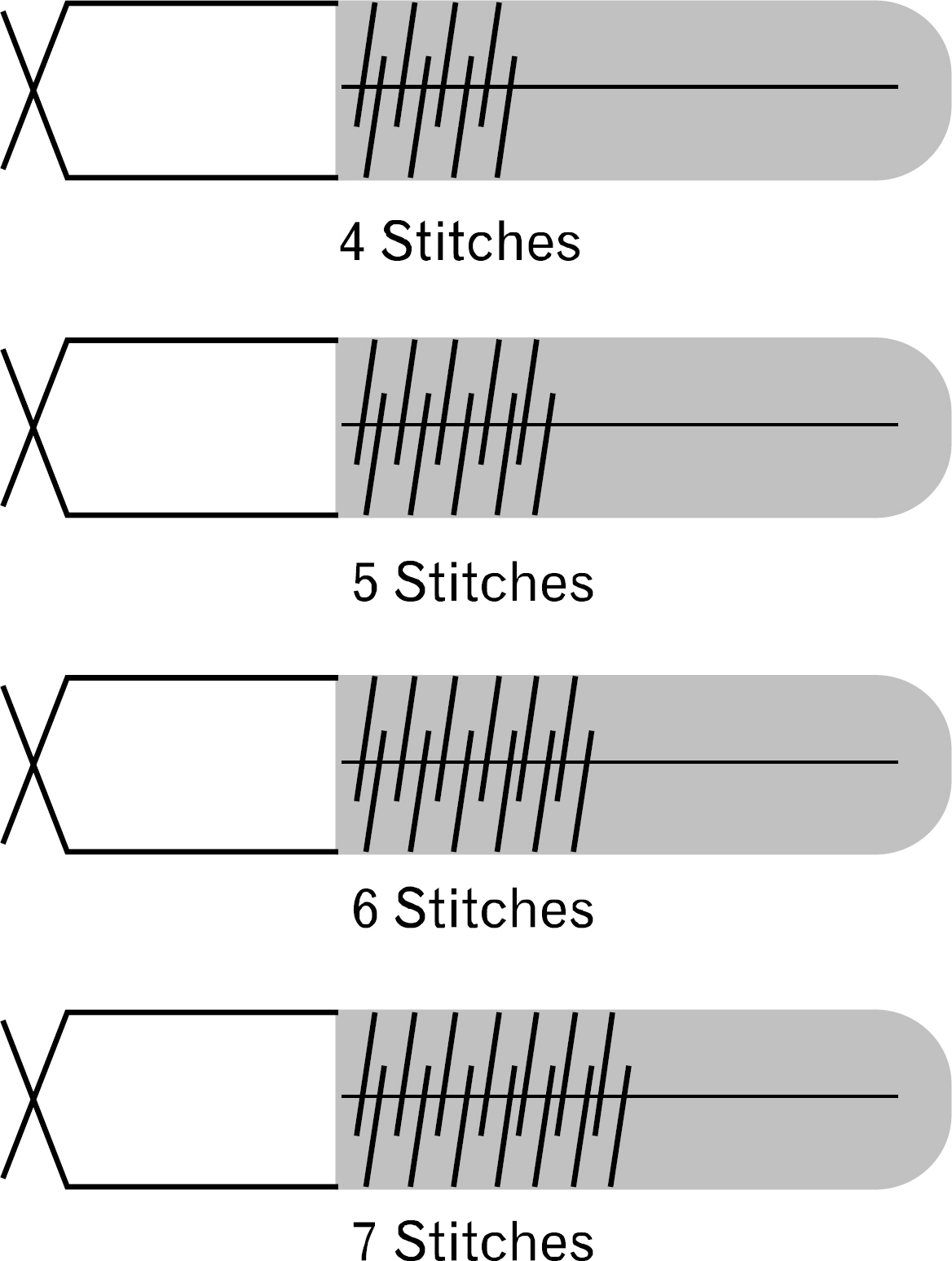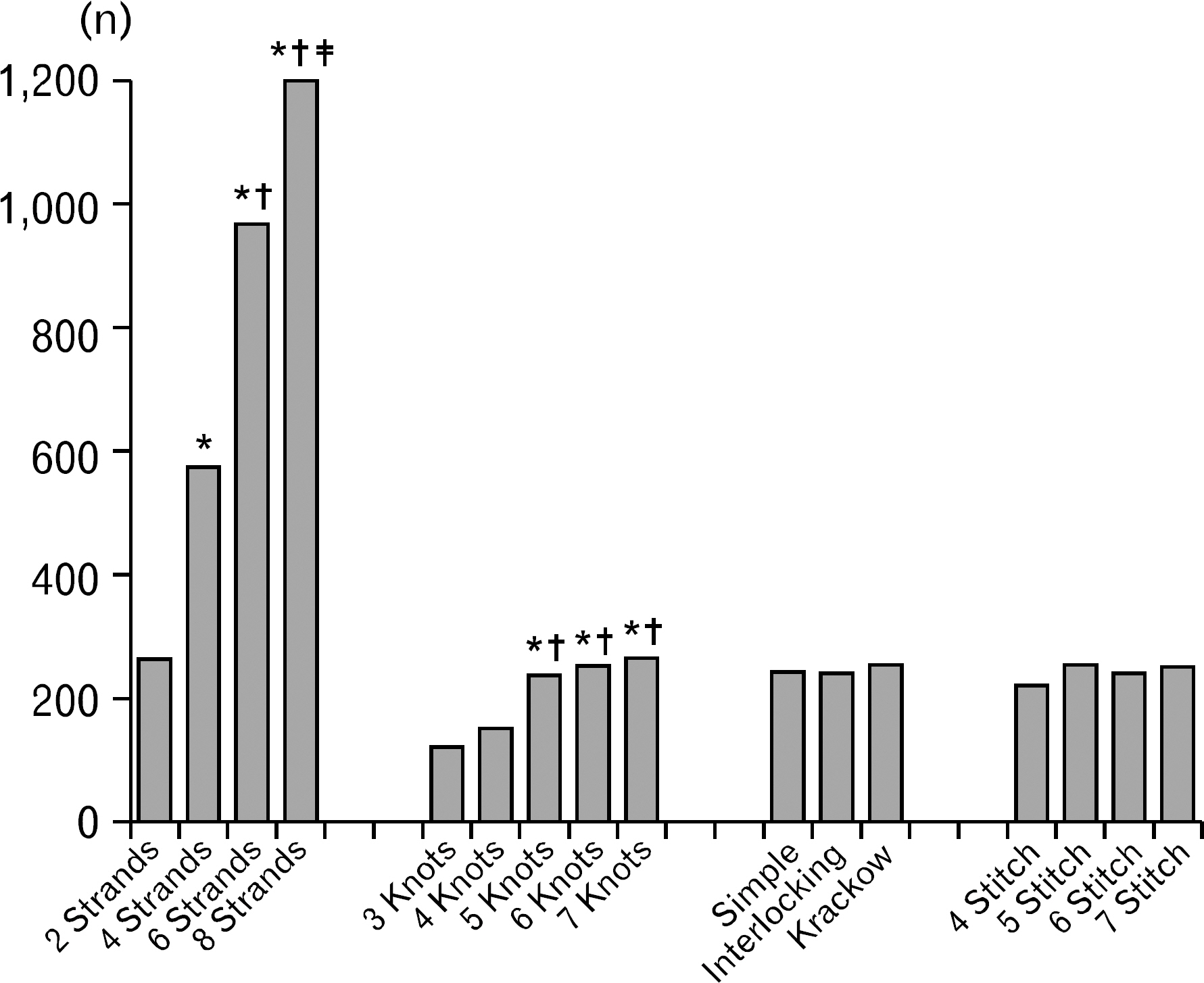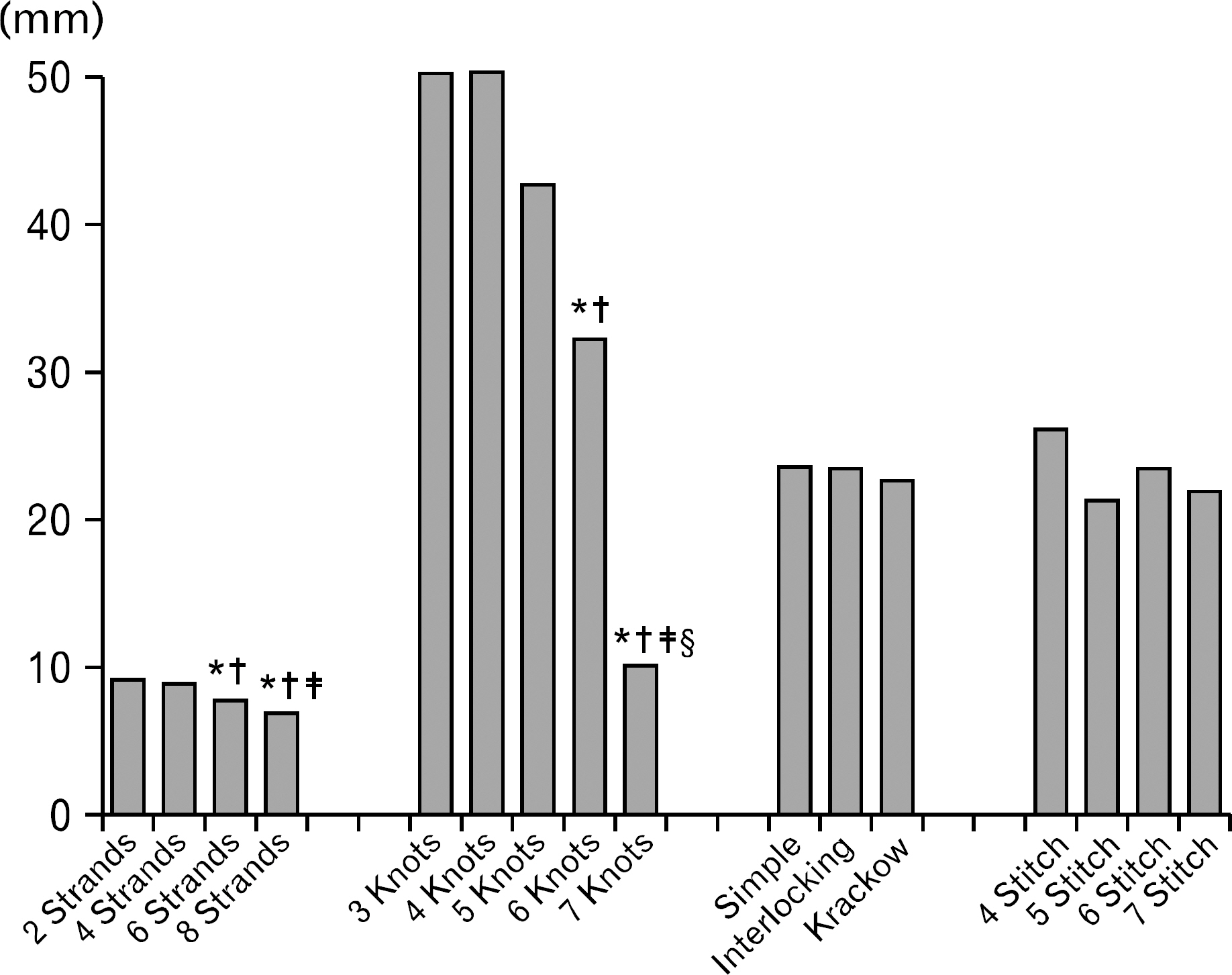Korean J Sports Med.
2014 Jun;32(1):14-19. 10.5763/kjsm.2014.32.1.14.
Optimal Parameters for Sutures Tied to a Post during Anterior Cruciate Ligament Reconstruction: Thread Numbers, Knot Numbers, Suture Techniques and Stitch Numbers: An Experimental Laboratory Study Using Porcine Tendon
- Affiliations
-
- 1Department of Orthopaedics, Gil Hospital, Gachon University, Incheon, Korea. bklee@gilhospital.com
- 2Gachon Medical School, Gachon University, Incheon, Korea.
- 3Solco Biomedical Institute, Solco Biomedical, Pyeongtaek, Korea.
- KMID: 2288685
- DOI: http://doi.org/10.5763/kjsm.2014.32.1.14
Abstract
- We evaluated the conditions required for sutures tied to a post for tibial fixation during anterior cruciate ligament (ACL) reconstruction. Harvested porcine tendon was used as a graft material and nonabsorbable suture was used for sutures. Samples were tested for ultimate tensile load and elongation according to thread numbers, knot numbers, suture techniques and stitch numbers. As thread numbers were increased, ultimate tensile load was increased and elongation was decreased. However, more than 4 strands of threads provided the sufficient ultimate tensile load more than 454 N of normal ACL for daily activities. As knot numbers were increased, ultimate tensile load was increased, but elongation was decreased. In terms of failure mode, unraveling occurred 100% in 3 and 4 knots, 81.2% in 5 knots, 54.5% in 6 knots, and 0% in 7 knots. Suture techniques and stitch numbers didn't significantly affect the ultimate tensile load and the elongation. For sutures tied to a post for tibial fixation in ACL reconstruction, more than 4 threads, more than 7 knots, and more than 4 stitches provide adequate ultimate tensile load and elongation.
MeSH Terms
Figure
Reference
-
1. Krackow KA, Thomas SC, Jones LC. A new stitch for ligament-tendon fixation. Brief note. J Bone Joint Surg Am. 1986; 68:764–6.
Article2. Fanelli GC, Desai GM, Cummings PD, Hanks GA, Kalanak A. Divergent alignment of the femoral interference screw in single incision endoscopic reconstruction of the anterior cruciate ligament. Contemp Orthop. 1994; 28:21–5.3. Pierz K, Baltz M, Fulkerson J. The effect of Kurosaka screw divergence on the holding strength of bone-tendon-bone grafts. Am J Sports Med. 1995; 23:332–5.
Article4. Zantop T, Weimann A, Schmidtko R, Herbort M, Raschke MJ, Petersen W. Graft laceration and pullout strength of soft-tissue anterior cruciate ligament reconstruction: in vitro study comparing titanium, poly-d,l-lactide, and poly-d,l- lactide-tricalcium phosphate screws. Arthroscopy. 2006; 22:1204–10.5. Park DK, Fogel HA, Bhatia S, et al. Tibial fixation of anterior cruciate ligament allograft tendons: comparison of 1-, 2-, and 4-stranded constructs. Am J Sports Med. 2009; 37:1531–8.6. Weiler A, Windhagen HJ, Raschke MJ, Laumeyer A, Hoffmann RF. Biodegradable interference screw fixation exhibits pullout force and stiffness similar to titanium screws. Am J Sports Med. 1998; 26:119–26.
Article7. Giurea M, Zorilla P, Amis AA, Aichroth P. Comparative pullout and cyclic-loading strength tests of anchorage of hamstring tendon grafts in anterior cruciate ligament reconstruction. Am J Sports Med. 1999; 27:621–5.8. Magen HE, Howell SM, Hull ML. Structural properties of six tibial fixation methods for anterior cruciate ligament soft tissue grafts. Am J Sports Med. 1999; 27:35–43.
Article9. Post WR, King SS. Neurovascular risk of bicortical tibial drilling for screw and spiked washer fixation of soft-tissue anterior cruciate ligament graft. Arthroscopy. 2001; 17:244–7.
Article10. Kousa P, Jarvinen TL, Vihavainen M, Kannus P, Jarvinen M. The fixation strength of six hamstring tendon graft fixation devices in anterior cruciate ligament reconstruction. Part II: tibial site. Am J Sports Med. 2003; 31:182–8.
Article11. Muller W. The knee: form, function, and ligament reconstruction. Berlin Springer-Verlag. 1983.12. Coleridge SD, Amis AA. A comparison of five tibial-fixation systems in hamstring-graft anterior cruciate ligament reconstruction. Knee Surg Sports Traumatol Arthrosc. 2004; 12:391–7.
Article13. Brand J Jr, Weiler A, Caborn DN, Brown CH Jr, Johnson DL. Graft fixation in cruciate ligament reconstruction. Am J Sports Med. 2000; 28:761–74.
Article14. Noyes FR, Butler DL, Grood ES, Zernicke RF, Hefzy MS. Biomechanical analysis of human ligament grafts used in knee-ligament repairs and reconstructions. J Bone Joint Surg Am. 1984; 66:344–52.
Article15. Morrison JB. Function of the knee joint in various activities. Biomed Eng. 1969; 4:573–80.16. Morrison JB. The mechanics of the knee joint in relation to normal walking. J Biomech. 1970; 3:51–61.
Article
- Full Text Links
- Actions
-
Cited
- CITED
-
- Close
- Share
- Similar articles
-
- A Biomechanical Study of Graft Fixation in Posterior Cruciate Ligament Reconstruction
- Anterior Cruciate Ligament Reconstruction with Achilles Tendon Allograft
- The Reconstruction of Anterior Cruciate Ligament Using Patellar Tendon under Arthroscopy
- Reconstruction of Posterior Cruciate Ligament Using Semitendinosus Tendon (3 cases)
- Reconstruction of the Anterior Cruciate Ligament using an Achilles Tendon Autograft: Preliminary Study





